Differentiation between low- and high-efficacy CB1 receptor agonists using a drug discrimination protocol for rats
- PMID: 24005529
- PMCID: PMC3947118
- DOI: 10.1007/s00213-013-3257-8
Differentiation between low- and high-efficacy CB1 receptor agonists using a drug discrimination protocol for rats
Abstract
Rationale: The "subjective high" from marijuana ingestion is likely due to Δ(9)-tetrahydrocannabinol (THC) activating the central cannabinoid receptor type 1 (CB1R) of the endocannabinoid signaling system. THC is a weak partial agonist according to in vitro assays, yet THC mimics the behavioral effects induced by more efficacious cannabinergics. This distinction may be important for understanding similarities and differences in the dose-effect spectra produced by marijuana/THC and designer cannabimimetics ("synthetic marijuana").
Objective: We evaluated if drug discrimination is able to functionally detect/differentiate between a full, high-efficacy CB1R agonist [(±)AM5983] and the low-efficacy agonist THC in vivo.
Materials and methods: Rats were trained to discriminate between four different doses of AM5983 (0.10 to 0.56 mg/kg), and vehicle and dose generalization curves were determined for both ligands at all four training doses of AM5983. The high-efficacy WIN55,212-2 and the lower-efficacy (R)-(+)-methanandamide were examined at some AM5983 training conditions. Antagonism tests involved rimonabant and WIN55,212-2 and AM5983. The separate (S)- and (R)-isomers of (±)AM5983 were tested at one AM5983 training dose (0.30 mg/kg). The in vitro cyclic adenosine monophosphate (cAMP) assay examined AM5983 and the known CB1R agonist CP55,940.
Results: Dose generalization ed50 values increased as a function of the training dose of AM5983, but more so for the partial agonists. The order of potency was (R)-isomer > (±)AM5983 > (S)-isomer and AM5983 > WIN55,212-2 ≥ THC > (R)-(+)-methanandamide. Surmountable antagonism of AM5983 and WIN55,212-2 occurred with rimonabant. The cAMP assay confirmed the cannabinergic nature of AM5983 and CP55,940.
Conclusions: Drug discrimination using different training doses of a high-efficacy, full CB1R agonist differentiated between low- and high-efficacy CB1R agonists.
Conflict of interest statement
Figures


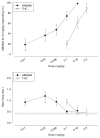
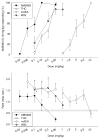

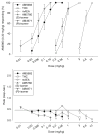
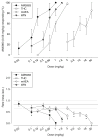
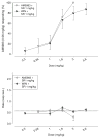

Similar articles
-
Central mediation and differential blockade by cannabinergics of the discriminative stimulus effects of the cannabinoid CB1 receptor antagonist rimonabant in rats.Psychopharmacology (Berl). 2011 Aug;216(3):355-65. doi: 10.1007/s00213-011-2226-3. Epub 2011 Mar 3. Psychopharmacology (Berl). 2011. PMID: 21369753 Free PMC article.
-
Discriminative stimulus functions of methanandamide and delta(9)-THC in rats: tests with aminoalkylindoles (WIN55,212-2 and AM678) and ethanol.Psychopharmacology (Berl). 2010 Jan;208(1):87-98. doi: 10.1007/s00213-009-1708-z. Epub 2009 Nov 10. Psychopharmacology (Berl). 2010. PMID: 19902182 Free PMC article.
-
Cannabinoid agonists differentially substitute for the discriminative stimulus effects of Delta(9)-tetrahydrocannabinol in C57BL/6J mice.Psychopharmacology (Berl). 2008 Jul;198(4):487-95. doi: 10.1007/s00213-007-0900-2. Epub 2007 Aug 3. Psychopharmacology (Berl). 2008. PMID: 17673980 Free PMC article.
-
[Drug discrimination properties and cytotoxicity of the cannabinoid receptor ligands].Nihon Arukoru Yakubutsu Igakkai Zasshi. 2012 Jun;47(3):135-43. Nihon Arukoru Yakubutsu Igakkai Zasshi. 2012. PMID: 22894054 Review. Japanese.
-
Pharmacological and Toxicological Effects of Synthetic Cannabinoids and Their Metabolites.Curr Top Behav Neurosci. 2017;32:249-262. doi: 10.1007/7854_2016_60. Curr Top Behav Neurosci. 2017. PMID: 28012093 Free PMC article. Review.
Cited by
-
Cannabinoid CB1 Discrimination: Effects of Endocannabinoids and Catabolic Enzyme Inhibitors.J Pharmacol Exp Ther. 2017 Dec;363(3):314-323. doi: 10.1124/jpet.117.244392. Epub 2017 Sep 25. J Pharmacol Exp Ther. 2017. PMID: 28947487 Free PMC article.
-
Discriminative Stimulus Properties of Phytocannabinoids, Endocannabinoids, and Synthetic Cannabinoids.Curr Top Behav Neurosci. 2018;39:153-173. doi: 10.1007/7854_2016_24. Curr Top Behav Neurosci. 2018. PMID: 27278640 Review.
-
Comparison of the discriminative stimulus and response rate effects of Δ9-tetrahydrocannabinol and synthetic cannabinoids in female and male rats.Drug Alcohol Depend. 2017 Mar 1;172:51-59. doi: 10.1016/j.drugalcdep.2016.11.035. Epub 2017 Jan 11. Drug Alcohol Depend. 2017. PMID: 28130989 Free PMC article.
-
Structure-Activity Relationship Development Efforts towards Peripherally Selective Analogs of the Cannabinoid Receptor Partial Agonist BAY 59-3074.Molecules. 2022 Sep 2;27(17):5672. doi: 10.3390/molecules27175672. Molecules. 2022. PMID: 36080443 Free PMC article.
-
Discovery of 1,3-disubstituted pyrazole peripheral cannabinoid receptor partial agonists.Bioorg Med Chem Lett. 2023 Sep 1;93:129430. doi: 10.1016/j.bmcl.2023.129430. Epub 2023 Aug 4. Bioorg Med Chem Lett. 2023. PMID: 37543275 Free PMC article.
References
-
- Abadji V, Lin S, Taha G, Griffin G, Stevenson LA, Pertwee RG, Makriyannis A. (R)-Methanandamide: a chiral novel anandamide possessing higher potency and metabolic stability. J Med Chem. 1994;37:1889–1893. - PubMed
-
- Adams IB, Compton DR, Martin BR. Assessment of anandamide interaction with the cannabinoid brain receptor: SR 141716A antagonism studies in mice and autoradiographic analysis of receptor binding in rat brain. J Pharmacol Exp Ther. 1998;284:1209–1217. - PubMed
-
- Alici T, Appel JB. Increasing the selectivity of the discriminative stimulus effects of delta-9-tetrahydrocannabinol: complete substitution with methanandamide. Pharmacol Biochem Behav. 2004;79:431–437. - PubMed
-
- Bergman J, France CP, Holtzman SG, Katz JL, Koek W, Stephens DN. Agonist efficacy, drug dependence, and medications development: preclinical evaluation of opioid, dopaminergic, and GABAAergic ligands. Psychopharmacol (Berl) 2000;153:67–84. - PubMed
-
- Bosier B, Muccioli GG, Hermans E, Lambert DM. Functionally selective cannabinoid receptor signalling: therapeutic implications and opportunities. Biochem Pharmacol. 2010;80:1–12. - PubMed
Publication types
MeSH terms
Substances
Grants and funding
LinkOut - more resources
Full Text Sources
Other Literature Sources

